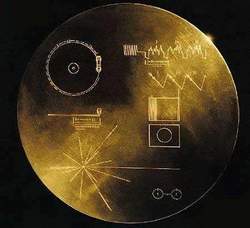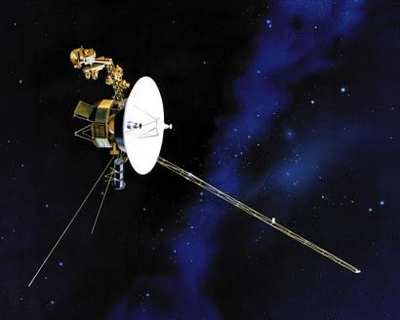Onward, Voyagers
The two venerable Voyager spacecraft are celebrating three
decades of flight as they head toward interstellar space. Their
ongoing odysseys mark an unprecedented and historic accomplishment,
according to the National Aeronautics and Space Administration.

Voyager 2 launched on August 20, 1977, and Voyager 1 launched on
September 5, 1977. They continue to return information from
distances more than three times farther away than Pluto.
"The Voyager mission is a legend in the annals of space
exploration. It opened our eyes to the scientific richness of the
outer solar system, and it has pioneered the deepest exploration of
the sun's domain ever conducted," said Alan Stern, associate
administrator for NASA's Science Mission Directorate, Washington.
"It's a testament to Voyager's designers, builders and operators
that both spacecraft continue to deliver important findings more
than 25 years after their primary mission to Jupiter and Saturn
concluded."
During their first dozen years of flight, the Voyagers made
detailed explorations of Jupiter, Saturn, and their moons, and
conducted the first explorations of Uranus and Neptune. The
Voyagers returned never-before-seen images and scientific data,
making fundamental discoveries about the outer planets and their
moons. The spacecraft revealed Jupiter's turbulent atmosphere,
which includes dozens of interacting hurricane-like storm systems,
and erupting volcanoes on Jupiter's moon Io. They also showed waves
and fine structure in Saturn's icy rings from the tugs of nearby
moons.
For the past 18 years, the twin Voyagers have been probing the
sun's outer heliosphere and its boundary with interstellar space.
Both Voyagers remain healthy and are returning scientific data 30
years after their launches.
 Voyager 1 currently is
the farthest human-made object, traveling at a distance from the
sun of about 15.5 billion kilometers (9.7 billion miles). Voyager 2
is about 12.5 billion kilometers (7.8 billion miles) from the sun.
Originally designed as a four-year mission to Jupiter and Saturn,
the Voyager tours were extended because of their successful
achievements and a rare planetary alignment. The two-planet mission
eventually became a four-planet grand tour. After completing that
extended mission, the two spacecraft began the task of exploring
the outer heliosphere.
Voyager 1 currently is
the farthest human-made object, traveling at a distance from the
sun of about 15.5 billion kilometers (9.7 billion miles). Voyager 2
is about 12.5 billion kilometers (7.8 billion miles) from the sun.
Originally designed as a four-year mission to Jupiter and Saturn,
the Voyager tours were extended because of their successful
achievements and a rare planetary alignment. The two-planet mission
eventually became a four-planet grand tour. After completing that
extended mission, the two spacecraft began the task of exploring
the outer heliosphere.
"The Voyager mission has opened up our solar system in a way not
possible before the Space Age," said Edward Stone, Voyager project
scientist at the California Institute of Technology in Pasadena,
CA. "It revealed our neighbors in the outer solar system and showed
us how much there is to learn and how diverse the bodies are that
share the solar system with our own planet Earth."
In December 2004, Voyager 1 began crossing the solar system's
final frontier. Called the heliosheath, this turbulent area,
approximately 14 billion kilometers (8.7 billion miles) from the
sun, is where the solar wind slows as it crashes into the thin gas
that fills the space between stars. Voyager 2 could reach this
boundary later this year, putting both Voyagers on their final leg
toward interstellar space.
Each spacecraft carries five fully functioning science
instruments that study the solar wind, energetic particles,
magnetic fields and radio waves as they cruise through this
unexplored region of deep space. The spacecraft are too far from
the sun to use solar power. They run on less than 300 watts, the
amount of power needed to light up a bright light bulb. Their
long-lived radioisotope thermoelectric generators provide the
power.
"The continued operation of these spacecraft and the flow of
data to the scientists is a testament to the skills and dedication
of the small operations team," said Ed Massey, Voyager project
manager at NASA's Jet Propulsion Laboratory in Pasadena, Calif.
Massey oversees a team of nearly a dozen people in the day-to-day
Voyager spacecraft operations.
The Voyagers call home via NASA's Deep Space Network, a system
of antennas around the world. The spacecraft are so distant that
commands from Earth, traveling at light speed, take 14 hours
one-way to reach Voyager 1 and 12 hours to reach Voyager 2. Each
Voyager logs approximately 1 million miles per day.
Each of the Voyagers carries a golden record (shown above,
right) that is a time capsule with greetings, images and sounds
from Earth. The records also have directions on how to find Earth
if the spacecraft is recovered by something or someone.

NASA's latest outer planet exploration mission is New Horizons,
which is now well past Jupiter and headed for a historic
exploration of the Pluto system in July 2015.
 ANN's Daily Aero-Term (05.18.25): Flight Recorder
ANN's Daily Aero-Term (05.18.25): Flight Recorder Aero-News: Quote of the Day (05.18.25)
Aero-News: Quote of the Day (05.18.25) Classic Aero-TV: ELA Aviation Sports New Vertical Takeoff Gyroplane
Classic Aero-TV: ELA Aviation Sports New Vertical Takeoff Gyroplane Airborne 05.19.25: Kolb v Tornados, Philippine Mars, Blackhawk Antler Theft
Airborne 05.19.25: Kolb v Tornados, Philippine Mars, Blackhawk Antler Theft Klyde Morris (05.16.25)
Klyde Morris (05.16.25)





